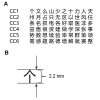Visual Demand and Acuity Reserve of Chinese versus English Newspapers
- PMID: 33055507
- PMCID: PMC7592886
- DOI: 10.1097/OPX.0000000000001585
Visual Demand and Acuity Reserve of Chinese versus English Newspapers
Abstract
Significance: This study suggests that Chinese newspaper characters are more legible than English newspaper letters. Characters in Chinese newspapers have higher acuity reserve than English newspapers.
Purpose: The purpose of this study was to evaluate visual demand and acuity reserve for Chinese newspapers in comparison with published data on U.S. newspapers.
Methods: The test distances for visual acuity in Chinese clinical studies were reviewed systematically. Characters from different sections of newspapers printed in simplified Chinese were evaluated. The character height, frequency, and visual demand and acuity reserve of each newspaper section were determined for Chinese characters of the six different levels of complexity.
Results: More than 70% of Chinese clinical studies measure near visual acuity at either 33 or 40 cm. The height of Chinese characters ranged from 1.95 to 3.28 mm across different sections of five newspapers compared with 1.0 to 2.0 mm for English letters. The frequency of Chinese characters from least to most complex ranged from 7 to 34% across 12 sections of one Chinese newspaper. The angular threshold across the six complexity levels of Chinese characters ranged from 4.62 to 5.93 arcmin (0.54 to 0.69 mm at 40-cm reading distance) with a weighted angular threshold of 5.18 arcmin compared with 3.37 arcmin (0.39 mm) for the English letters. For Chinese newspapers, at 40-cm reading distance, the acuity reserve for the smallest and largest median size was 3.55 and 4.61, respectively.
Conclusions: Chinese characters are larger than English characters in all newspaper sections newspapers by a factor of 1.60 to 2.34. Given that Chinese characters need to be 1.54 times larger than English letters to provide the same acuity reserve, on average, Chinese newspapers are more legible than U.S. English newspapers.
Conflict of interest statement
Figures



Similar articles
-
Visual requirement for Chinese reading with normal vision.Brain Behav. 2019 Apr;9(4):e01216. doi: 10.1002/brb3.1216. Epub 2019 Feb 21. Brain Behav. 2019. PMID: 30793523 Free PMC article.
-
Effect of pattern complexity on the visual span for Chinese and alphabet characters.J Vis. 2014 Jul 3;14(8):6. doi: 10.1167/14.8.6. J Vis. 2014. PMID: 24993020 Free PMC article.
-
Legibility variations of Chinese characters and implications for visual acuity measurement in Chinese reading population.Invest Ophthalmol Vis Sci. 2007 May;48(5):2383-90. doi: 10.1167/iovs.06-1195. Invest Ophthalmol Vis Sci. 2007. PMID: 17460306
-
Crowding and eccentricity determine reading rate.J Vis. 2007 Oct 26;7(2):20.1-36. doi: 10.1167/7.2.20. J Vis. 2007. PMID: 18217835 Review.
-
Does print size matter for reading? A review of findings from vision science and typography.J Vis. 2011 Aug 9;11(5):10.1167/11.5.8 8. doi: 10.1167/11.5.8. J Vis. 2011. PMID: 21828237 Free PMC article. Review.
Cited by
-
Morphological and Clinical Characterization of Foveal Bulge Sign Three Years After Retinal Detachment Repair: A Longitudinal Prospective Evaluation.Clin Ophthalmol. 2024 Aug 13;18:2261-2270. doi: 10.2147/OPTH.S463004. eCollection 2024. Clin Ophthalmol. 2024. PMID: 39157048 Free PMC article.
-
Visual Outcomes and Patient Satisfaction of Trifocal or Trifocal Toric IOLs in Chinese Cataract Patients: Focus on Near Vision at 33 cm.Clin Ophthalmol. 2024 May 25;18:1447-1456. doi: 10.2147/OPTH.S464586. eCollection 2024. Clin Ophthalmol. 2024. PMID: 38813540 Free PMC article.
-
Clinical outcomes in eyes with diffractive continuous depth-of-focus intraocular lenses enhanced for near vision: comparison with trifocal intraocular lenses.BMC Ophthalmol. 2023 Nov 21;23(1):475. doi: 10.1186/s12886-023-03207-6. BMC Ophthalmol. 2023. PMID: 37990206 Free PMC article. Clinical Trial.
-
Analysis of Daily Visual Habits in a Presbyopic Population.J Ophthalmol. 2023 Apr 8;2023:6440954. doi: 10.1155/2023/6440954. eCollection 2023. J Ophthalmol. 2023. PMID: 37089413 Free PMC article.
References
-
- National Research Council Visual Task Performance. In: Lennie P, Hemel SB, eds. Visual Impairments: Determining Eligibility for Social Security Benefits. Committee on Disability Determination for Individuals with Visual Impairments. Washington, DC: National Academy Press; 2002:126–98. - PubMed
-
- Flax N. Visual Factors Which Affect Reading Achievement. St. Louis, MO: American Optometric Association; 1968.
-
- Whittaker SG, Lovie-Kitchin J. Visual Requirements for Reading. Optom Vis Sci 1993;70:54–65. - PubMed
-
- McMonnies CW. Chart Construction and Letter Legibility/Readability. Ophthalmic Physiol Opt 1999;19:498–506. - PubMed
MeSH terms
LinkOut - more resources
Full Text Sources

